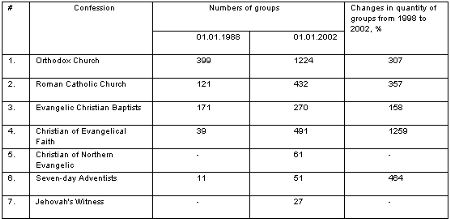Belarus
Literature
Belarusian publishing has had a notable impact on the region: Belarusian bibles were some of the first books to be printed in Eastern Europe, and the 17th century Belarusian poet, Symeon of Polatsk, introduced the Baroque style of literature to Russia. Modern Belarusian literature was born in the 19th century - Jakub Kolas is considered the classical pioneer, while Natalla Arseneva, author of Beneath the Blue Sky, is known as a paragon of 20th century literature. Local writers were stifled by the Soviet occupation, but the literary scene is now undergoing a revival.
Religion
Belarus, like Ukraine, has always been a crossing point between Latin and Eastern Orthodox Christianity. Around 70% of Belarusians are Eastern Orthodox, but a sizeable Roman Catholic population (which dominates the clergy) has resulted from centuries of Polish rule. There's also a scattering of Protestants (a remnant of the once-large German population), Muslims (mainly Tatars) and Jews, although many of these are emigrating.
Table presents information about numbers and trends within the most popular religious organizations:
Language
Belarusian is an Eastern Slavonic language, related to Russian and Ukrainian. It's usually written in Cyrillic, but there's a rarely-used Roman Belarusian alphabet. Under Soviet rule, 80% of Belarusian children were taught exclusively in Russian, and Russian was the official language of all business and government transactions. In 1990, Belarusian was made the country's official language. Street names are now changing, and education is shifting its emphasis back to Belarusian history and literature. However, Russian is still the most widely-spoken language.
Food & Drinks
The Belarusians love their mushrooms, and gathering them is something of a local ritual. Many main dishes use fungus in one way or another - in a rich sauce, in a creamy filling, or by itself. Popular dishes include hrybi v smtane (mushrooms with sour cream), hribnoy sup (mushroom and barley soup) and kotleta pokrestyansky (pork cutlet with mushroom sauce). Other important ingredients are garlic, fish and caraway. Kvas is a favoured drink made from malt flour, sugar, mint and fruit.
Music
The country has a strong musical tradition and many 12th century Orthodox hymns and sermons had their origins in Belarus. Belarusian folk music is well known; don't miss a performance if you get the opportunity. Modern folk music originated from ritualistic ceremonies or church music, and became highly developed from the 16th century onwards. Belarusian classical music is a 20th century phenomenon, though this hasn't stopped the Minsk opera and ballet companies from earning international reputations.
History of folk and classical music
The sources of the traditional Belarusian music are in the popular music of Eastern Slavs of the Kievan Rus period. The first bearers of secular professional tradition were skomorokhs.
By the 15th century the local type of “znamennogo” descant in the orthodox church music appeared.
In the musical culture of the second half of the 16th - beginning of the 17th centuries were reflected the tendencies of Renaissance and ideas of Reformation.
In the 17th century “Partesnoe” singing (choral concerts, psalms) was set.
In the 18th century private theatres and chapels of the Radizivils, Sapegas, Oginskys and other nobles became the centres of musical culture. Since the beginning of the 19th century there were in big towns (Vitebsk, Grodno, Minsk, Mogilev) city orchestras, performances were staged there.
In 1918-21 in Vitebsk, Minsk, Gomel, Bobruisk popular conservatories were established, which later transformed into musical secondary educational institutions and schools. The Belarusian musical secondary educational institution was founded in Minsk (1924, now - the Minsk musical college named after M.I.Glinka). the first national operas were “Mikhas Podgorny” by E.Tikotsky, “In Virgin Forests of Polesie” by A.Bogatyrev (staged in 1939), “The Flower of Happiness” by A.Turenkov (staged in 1940). The first ballet was “The Nightingale” by M.Kroshner (staged in 1939).Rock
Basic rock and pop traditions in Belarusian music were established already in the soviet time by the well known on the territory of the USSR groups Pesniary, Siabry, Verasy. New period in Belarusian rock music has started after disintegration of the Soviet Union and is mainly assosiated with such bands as Krama, Ulis, Tornado, N.R.M (formerly Mroya), which still exist and perform on concerts.
Other modern big names are Neuro-dubel, Hasta La Fillsta, The Stoks, Little Blues Band.Pop
Belarus has gained some tangible results in this sphere and Belarusian pop performers became popular at least on the territory of former USSR. The big names today are first of all Lika, Lyapis Trubetskoy, Boris Moiseev.
Dance (techno, electronic, etc)
This kind of music is developing quickly in Belarus and there are many admirers among the youth. There is quite a number of bands performing in this style mainly in clubs, on discos and small concerts, though none of them have gained any significant popularity beyond national borders. Locally recognized are bands like Drum XTC, Autism, KaSlukaDaKovaliov, Lepricons
National Anthem
To listen the national anthem click here.
